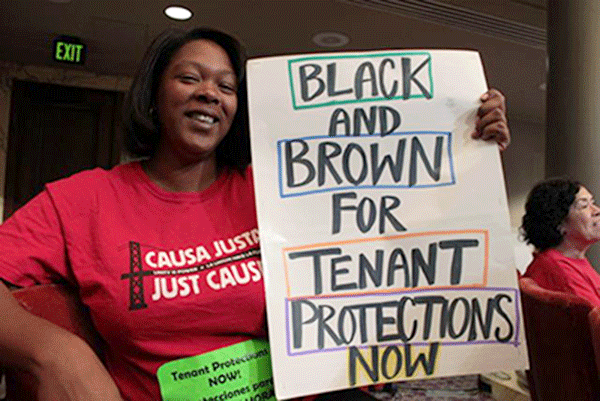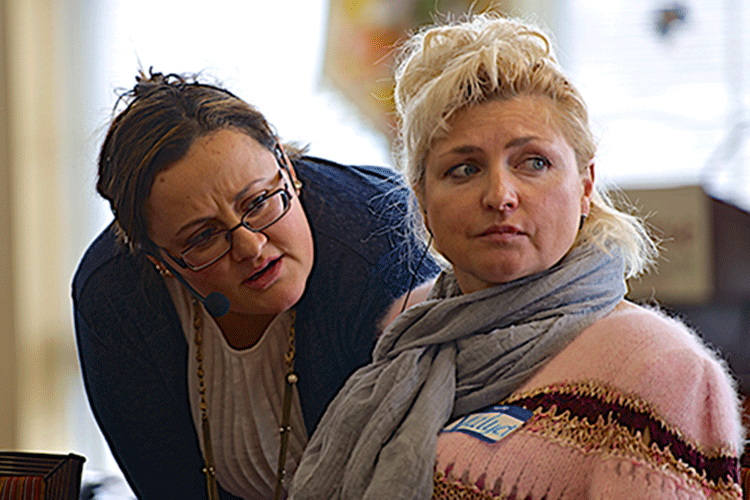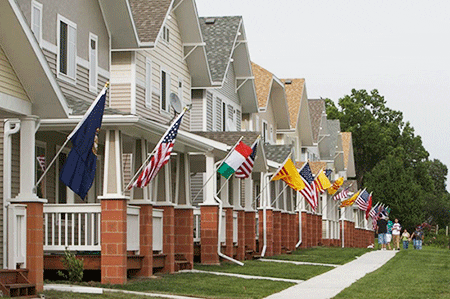
Miriam Axel-Lute: Tell me about the problems with landlords and immigration status. . .
Kitzia Esteva-Martinez: Causa Justa thought the tenant protection ordinance was an important fight around stopping all of the displacement that we’re seeing in our cities in the Bay area. A lot of our tenants were coming to our clinic, telling us that the landlord was threatening [that they would] call the police or ICE (Immigration and Customs Enforcement) if they asked for repairs, or if they asked for minimal things that they needed that were within their rights, as a tactic to push them out of housing. [What to do if ICE comes to a building your nonprofit owns.] In the context of gentrification, landlords have an incentive to push people out of housing in order to then get a renter that will probably pay twice or three times as much. We are definitely seeing a lot of tactics that landlords are using to do that that are outside the law.
It [is] harassment of different kinds, and using the understanding that immigrant tenants have that if the police get called, because of police/ICE collaboration, they’re going to be in a situation where they could be potentially deported—enlisting that fear of the police, of immigration agencies, to push people out of housing. A lot of tenants were like, “Should I move? Should I move tomorrow?”
Or, they were telling us, “The landlord hasn’t fixed anything for the last seven, eight years,” and I’m taking care of things myself because he said ‘You’re here undocumented, you actually don’t have a right to be here, and you’re here under the condition that you don’t ask me for anything.’
Those were all things that we were trying to tackle in this legislation, along with a lot of other tenant issues that go beyond undocumented tenants’ rights. Working-class folks of color come to our clinic every day with very similar things: their landlord hasn’t repaired things, they’ve been living for months, or even years, in uninhabitable conditions, and their landlords are harassing them.
Miriam Axel-Lute: So, many of the problems are similar for everyone, and immigration status is an additional lever that the landlords were using in the harassment?
Kitzia Esteva-Martinez: Yes. And so, the legislation actually addresses a series of things that are defined as harassment—and threatening to call immigration enforcement on undocumented tenants is one of the things that is defined as harassment.
Also, not responding to requests for repairs and letting people live under uninhabitable conditions are also defined as forms of harassment. So we were able to have strict definitions of the harassment that tenants are experiencing every day in Oakland.
Miriam Axel-Lute: That’s great. And what’s the penalty for the landlords for harassment?
Kitzia Esteva-Martinez: We’re still working on some of that. What we have in the ordinance currently is that tenants can file a petition for rent rate adjustment, and that they can take landlords to court based on this.
What we want to add onto the legislation is administrative relief; some aspect of the Oakland Rent Board or a housing agency that could actually be vigilant when people make complaints about harassment, and having a way to actually follow through through the city without the tenants having to go through the court. It’s great that we can take landlords to court, however, the resources that working-class and low-income tenants have to actually do that is almost nonexistent. We don’t have resources in the city for that, and community agencies already are dealing with an overflow of people needing legal support and not having the ability to serve everyone. Having the administration take care of how they enforce the legislation is something really important that we’re still trying to get the city of Oakland to include in the ordinance.
Miriam Axel-Lute: Do you have particular stories of members and their experiences with their landlords that the kinds of harassment that the landlords were carrying out?
Kitzia Esteva-Martinez: One was when we were starting to prepare for the ordinance. We were organizing a couple of tenants in a predominantly Latino neighborhood in Oakland. One of our recent recruits has a son who is a teenager. The landlord hadn’t fixed their bedroom, and she had a leak in the toilet for probably three years.
She got inspectors involved, but as she was starting to defend her rights, the landlord realized that she was going to get help, and he threatened her and said, “If you continue to do this, I’m going to call the police, and I’m going to get your son in trouble.” She didn’t listen, but the landlord called the police saying that her son had stolen something from a neighbor’s house. The police came and arrested the son, who was a minor. Were it not for our due process legislation in Alameda County, he would have been turned over to ICE, because he is also undocumented.
That experience made her feel like “I have to move out. I can’t wait here for my son to get in a situation where he could end up deported.” This is the kind of experience that people were having and are having, but less now that the legislation was passed.
Miriam Axel-Lute: Tell me more about that due process legislation that you mentioned.
Kitzia Esteva-Martinez: The due process legislation involves Oakland and San Francisco counties. It’s addressing the way in which the local police works. It was integrated into policing immigrants. We were seeing racial profiling based on the Secure Communities Program. The police were arresting anyone for whatever reason, and holding them to turn them over to ICE. In many instances, even people that had to call the police because something happened to them—[like] women that had called the police due to domestic violence, saw themselves involved in this web of police/ICE collaboration and ended up in deportation proceedings.
So we had a legislative fight, both in San Francisco and Oakland, to assert that turning people over to ICE and not having due process was, in fact, discriminatory and unconstitutional. The legislation that we have now in both cities around police/ICE collaboration prohibits the police from turning people over to immigration agents after their arrest in our local jail.
Miriam Axel-Lute: When organizing for the Tenant Protection Ordinance, did you encounter any anti-immigrant feeling among non-immigrant tenants who were experiencing the same problems?
Kitzia Esteva-Martinez: There wasn’t anything specific. I think how we organize, around what it means for tenants to be in solidarity with each other, [and] the ways in which they experience harassment and uninhabitable conditions helps.
We are an organization that does Black and Brown unity organizing. We are very aware of each other’s needs and the differences in how they are experiencing the impact of gentrification and harassment. A lot of our Black leaders and tenants, they didn’t know a lot of the issues that undocumented, mostly Latino immigrants were experiencing around harassment and the level of fear that they were experiencing because of police/ICE collaboration. There was a lot of listening to each other and really being able to hear each other’s stories. Black tenants can understand fear around police harassment and [other] issues that they experience also but in the context of anti-Black racism. So, the connections were there.
We never just discuss the similarities; we really talk about differences to approach the need for solidarity, rather than just, “Oh, we’re all dealing with the same issues, right?” Because when we don’t look at the specificities, we lose part of the picture of what needs to happen.
Miriam Axel-Lute: Can you tell me more about the history of the Black and Brown unity organizing that Causa Justa/Just Cause has been doing?
Kitzia Esteva-Martinez: Causa Justa/Just Cause comes out of a very exciting merger that happened between two organizations, one that was primarily organizing Black tenants in Oakland, Just Cause Oakland, and St. Peter’s Housing Committee in San Francisco, which mostly organized Latino tenants. They were seeing each other at a lot of events and rallies and trying to figure out an approach to address the gentrification that both communities were facing. There were beginning conversations about, “We should be thinking about how to work together more often,” and it became obvious to everyone that we needed to be one organization, and that we could be stronger together in pushing forward development without gentrification in our cities. The merger was something that members wanted, and the staff leadership of the organization wanted.
We work on both solidarity around gentrification and displacement that Black and Latino communities face in the Bay area, and on political education, having spaces where Black and Latino tenants can talk to each other and can share with each other, and have tools to understand issues that they’re facing. And from that also build more of the political framework on how we fight this.
The remak[ing] of our cities that we’re experiencing is about displacement of working-class, low-income families, and that makes sense as a point of unity. On the other hand, the immigrant rights campaign of CJJC is a campaign that focuses on Latino immigrant issues and has mostly Latino immigrant membership. That came from Latino immigrants, but also Black leaders, who understood it as something that needed to happen with a Latino base.
Miriam Axel-Lute: Do you have some examples from those conversations where people started off not really having a good sense of how solidarity worked, and there was a particular moment where they got it?
Kitzia Esteva-Martinez: We were having a conversation about three years ago when immigration reform was a really key topic, and there was a lot of conversation about how what we, as an organization doing immigrant rights work, need to [have] happen around immigration reform.
We were reviewing some of the proposals that were coming out of the Senate, and discussing what we were supporting and what we were rejecting. Our membership meetings are usually members from Causa Justa that live in Oakland and San Francisco, and are Black and Latino. A lot of the Latino members were actually more on the side of, “If we need to make compromises around having stronger restrictions on immigration to be able to get immigration reform and legalization, we could compromise on some of the things”
It was interesting, Latino members talking about legalization being what would alleviate a lot of their communities’ troubles, and then a lot of the Black leaders saying, “Well, we have that, but it’s not just about legalization and citizenship. It’s about policies across the board, policies of racism.”
And there were conversations about what would it look like if the money used on immigration enforcement was actually going to our schools, social services, and different things, and it was a very, very powerful conversation, where everybody came to the conclusion that the government is prioritizing the wrong things, and calling it public safety.
Miriam Axel-Lute: Do you have recommendations for other organizations that might be working on tenant issues who might not be starting with the basis of having worked on Black/Brown unity, but are maybe working on tenant issues and housing rights and want to think about immigrant rights or accommodate the specific experiences of their immigrant tenants?
Kitzia Esteva-Martinez: In the Bay Area we’ve modeled how immigrants should be treated, with our sanctuary ordinance in San Francisco and more recently our due process ordinance. But I think the most important thing, no matter what locality we’re in, no matter the conditions, is how we integrate the voices and the leadership of those who are being directly impacted. And that’s the work that Causa Justa is most committed to, because you can have policies, you can pass legislation without actually looking at every single aspect of how people are experiencing impact, and then you end up only fixing part of the problem.
It’s super-important to integrate documented and undocumented immigrant leadership into the fight itself, and also into the ways in which you understand the fight that you’re taking on, even when it comes to creating legislation. Something that has been really powerful for our leaders and for our organization is how the members are included in the process of making the language of the legislation. It was in fact, our members, who said protections against harassment based on immigrations status, and harassment based on habitability issues need to be included in the TPO, and that added to the strength of what we were able to fight for and win.
(Photo: Causa Justa/Just Cause staff member, courtesy of CJJC)





Miriam and Kitzia, thanks for this piece and high praise for the work of Kitzia and her CJJC colleagues in advancing the housing and immigration rights of vulnerable Oaklanders. The mainstream media loves to focus on conflict among communities of color and oppressed peoples, trying to trump up — or worse, invent — competition within the working class rather than shedding light on the widening gap between privileged elites and working folks fighting for economic, health and social equity. Glad Shelterforce is bringing national attention to CJJC’s movement-building work here in Oakland to establish a common-sense standard: the right of property owners to profit off market rate housing should not take priority over the rights of our children, families and elders to stay housed and stay together.